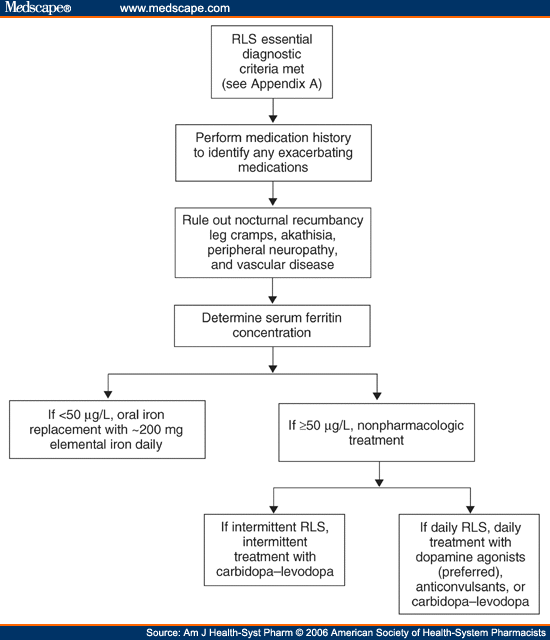Treatment Options and Guidelines
See Table 1 for common starting and final doses for the more common medications used to treat RLS. Few guidelines have been developed for RLS treatment. The American Academy of Sleep Medicine has issued two practice parameters for the dopaminergic treatment of RLS and PLMD.[124,125] The most recent was released in early 2004, before publication of the studies of ropinirole and FDA approval of its labeling for treatment of RLS.[125] This document recommended levodopa with a decarboxylase inhibitor or pergolide as having the most evidence for efficacy. Pramipexole was suggested as a second-line agent, and ropinirole and other agonists were suggested as treatment options. The guideline acknowledges issues with augmentation caused by levodopa, but does not mention heart valve issues with pergolide.
An algorithm published by the Medical Advisory Board of the Restless Legs Syndrome Foundation advises clinicians to take different treatment approaches for intermittent and daily RLS.[51] Some of the recommended treatments have no clinical data to support their use but are related to other agents that have been shown to improve RLS symptoms.
Because the risk of augmentation from treatment of intermittent RLS is less, the authors recommended carbidopa-levodopa and nonpharmacologic therapy.[51] Other agents recommended for intermittent RLS include codeine, propoxyphene, temazepam, tramadol, triazolam, zaleplon, and zolpidem. Dopamine agonists are also recommended; however, because of their slow onset of action, they are not considered as effective for intermittent use.
For daily RLS, nonpharmacologic therapy is recommended.[51] When it is insufficient, dopamine agonists, particularly pramipexole and ropinirole, are the drugs of choice. These agents are considered first line because of their favorable outcomes and less risk of augmentation, and they usually require once-daily administration compared with carbidopa-levodopa. Alternatives include codeine, gabapentin, propoxyphene, and tramadol, especially if RLS is associated with a painful neuropathy or other painful condition.
In addition to frequency of symptoms, treatment of RLS should be individualized with considerations for age, concomitant medications, co-morbid disease states, and history of augmentation or rebound. An algorithm for approaching a patient with RLS is proposed in Figure 1. Medications are usually initiated between one and three hours before bedtime. If the patient experiences rebound, either a controlled-release preparation of carbidopa-levodopa or additional doses of the other medications should be administered. Should augmentation develop, either the agent should be changed or additional doses should be given earlier during the day.
Figure 1.
Proposed algorithm for the treatment of restless legs syndrome (RLS).
Am J Health Syst Pharm. 2006;63(17):1599-1612. © 2006 American Society of Health-System Pharmacists
Cite this: Restless Legs Syndrome - Medscape - Sep 01, 2006.





Comments